Buckingham Palace - a Brief History
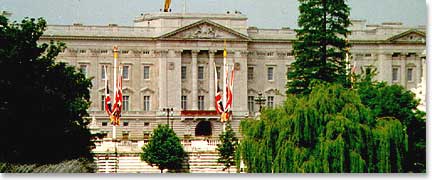
Buckingham Palace has served as the official London residence of Britain's sovereigns since 1837. It evolved from a town house that was owned from the beginning of the eighteenth century by the Dukes of Buckingham.
Today it is The Queen's official residence. Although in use for the many official events and receptions held by The Queen, areas of Buckingham Palace are opened to visitors on a regular basis.
The State Rooms of the Palace are open to visitors during the Annual Summer Opening in August and September. They are lavishly furnished with some of the greatest treasures from the Royal Collection - paintings by Rembrandt, Rubens, Vermeer, Poussin, Canaletto and Claude; sculpture by Canova and Chantrey; exquisite examples of Sevres porcelain; and some of the finest English and French furniture in the world.
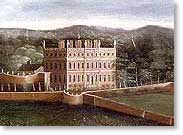
George III bought Buckingham House in 1761 for his wife Queen Charlotte to use as a comfortable family home close to St James's Palace, where many court functions were held. Buckingham House became known as the Queen's House, and 14 of George III's 15 children were born there.
In 1762 work began on remodelling the house to the King's requirements, to designs by Sir William Chambers, at a cost of 73,000 GBP.
George IV, on his accession in 1820, decided to reconstruct the house into a pied-a-terre, using it for the same purpose as his father George III.
As work progressed, and as late as the end of 1826, the King had a change of heart. With the assistance of his architect, John Nash, he set about transforming the house into a palace. Parliament agreed to a budget of 150,000 GBP, but the King pressed for 450,000 GBP as a more realistic figure.
Nash retained the main block but doubled its size by adding a new suite of rooms on the garden side facing west. Faced with mellow Bath stone, the external style reflected the French neo-classical influence favoured by George IV.
The remodelled rooms are the State and semi-State Rooms, which remain virtually unchanged since Nash's time.
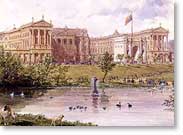
Many of the pieces of furniture and works of art in these rooms were bought or made for Carlton House (George IV's London base when he was Prince of Wales), which was demolished in 1827.
The north and south wings of Buckingham House were demolished and rebuilt on a larger scale with a triumphal arch - the Marble Arch - as the centrepiece of an enlarged courtyard, to commemorate the British victories at Trafalgar and Waterloo.
By 1829 the costs had escalated to nearly half a million pounds. Nash's extravagance cost him his job, and on the death of George IV in 1830, his younger brother William IV took on Edward Blore to finish the work.
The King never moved into the Palace. Indeed, when the Houses of Parliament were destroyed by fire in 1834, the King offered the Palace as a new home for Parliament, but the offer was declined.
Queen Victoria was the first sovereign to take up residence in July 1837, just three weeks after her accession, and in June 1838 she was the first British sovereign to leave from Buckingham Palace for a Coronation. Her marriage to Prince Albert in 1840 soon showed up the Palace's shortcomings.
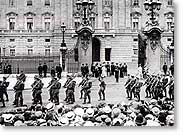
A serious problem for the newly married couple was the absence of any nurseries and too few bedrooms for visitors. The only solution was to move the Marble Arch - it now stands at the north-east corner of Hyde Park - and build a fourth wing, thereby creating a quadrangle.
Blore, the architect in charge, created the East Front and, thanks largely to his builder, Thomas Cubitt, the costs were reduced from 150,000 to 106,000 GBP. The cost of the new wing was largely covered by the sale of George IV's Royal Pavilion at Brighton.
Blore added an attic floor to the main block of the Palace and decorated it externally with marble friezes originally intended for Nash's Marble Arch. The work was completed in 1847.
By the turn of the century the soft French stone used in Blore's East Front was showing signs of deterioration, largely due to London's notorious soot, and required replacing.
In 1913 the decision was taken to reface the facade. Sir Aston Webb, with a number of large public buildings to his credit, was commissioned to create a new design. Webb chose Portland Stone, which took 12 months to prepare before building work could begin. When work did start it took 13 weeks to complete the refacing, a process that included removing the old stonework.
The present forecourt of the Palace, where Changing the Guard takes place, was formed in 1911, as part of the Victoria Memorial scheme.
The gates and railings were also completed in 1911; the North-Centre Gate is now the everyday entrance to the Palace, whilst the Central Gate is used for State occasions and the departure of the guard after Changing the Guard.
The work was completed just before the outbreak of the First World War in 1914.
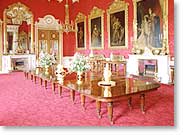
Besides being the official London residence of The Queen, Buckingham Palace is also the busy administrative headquarters of the Monarchy and has probably the most famous facade of any building in the world.
The Palace is a working building and the centrepiece of Britain's constitutional monarchy. It houses the offices of those who support the day-to-day activities and duties of The Queen and The Duke of Edinburgh and their immediate family.
The Palace is also the venue for great Royal ceremonies, State Visits and Investitures, all of which are organised by the Royal Household.
Although Buckingham Palace is furnished and decorated with priceless works of art that form part of the Royal Collection, one of the major art collections in the world today, it is not an art gallery and nor is it a museum.
Its State Rooms form the nucleus of the working Palace and are used regularly by The Queen and members of the Royal Family for official and State entertaining.
More than 50,000 people visit the Palace each year as guests to banquets, lunches, dinners, receptions and the Royal Garden Parties.
For those who do receive an invitation to Buckingham Palace, the first step across the threshold is into the Grand Hall and up the curving marble stairs of the Grand Staircase. Portraits are still set in the walls, as they were by Queen Victoria.
The Throne Room, sometimes used during Queen Victoria's reign for Court gatherings and as a second dancing room, is dominated by a proscenium arch supported by a pair of winged figures of 'victory' holding garlands above the 'chairs of state'.
It is in the Throne Room that The Queen, on very special occasions like Jubilees, receives loyal addresses. Another use of the Throne Room has been for formal wedding photographs.
George IV's original palace lacked a large room in which to entertain. Queen Victoria rectified that shortcoming by adding in 1853-5 what was, at the time of its construction, the largest room in London.
At 36.6m long, 18m wide and 13.5m high, the Ballroom is the largest multi-purpose room in Buckingham Palace. It was opened in 1856 with a ball to celebrate the end of the Crimean War.
It is along the East Gallery that The Queen and her State guests process to the Ballroom for the State Banquet normally held on the first day of the visit.
Around 150 guests are invited and include members of the Royal Family, the government and other political leaders, High Commissioners and Ambassadors and prominent people who have trade or other associations with the visiting country.
Today, it is used by The Queen for State banquets and other formal occasions such as the annual Diplomatic Reception attended by 1,500 guests.
This is a very formal occasion during which The Queen will meet every head of mission accredited to the Court of St James's. For the diplomats it is perhaps the highlight of the annual diplomatic social calendar.
The Ballroom has been used variously as a concert hall for memorial concerts and performances of the arts and it is the regular venue for Investitures of which there are usually 21 a year - nine in spring, two in the summer and ten in the autumn.
At Investitures, The Queen (or The Prince of Wales as her representative) will meet recipients of British honours and give them their awards, including knighting those who have been awarded knighthoods.
From the Ballroom, the West Gallery, with its four Gobelin tapestries, leads into the first of the great rooms that overlook lawn and the formal gardens - setting for the annual Garden Parties introduced by Queen Victoria in 1868.
The State Dining Room is one of the principal State Rooms on the West side of the Palace. Many distinguished people have dined in this room including the 24 holders of the Order of Merit as well as presidents and prime ministers.
Before the Ballroom was added to the Palace in the 1850s, the first State Ball was held in the Blue Drawing Room in May 1838 as part of the celebrations leading up to Queen Victoria's Coronation.
The Music Room was originally known as the Bow Drawing Room and is the centre of the suite of rooms on the Garden Front between the Blue and the White Drawing Rooms.
Four Royal babies - The Prince of Wales, The Princess Royal, The Duke of York and Prince William - were all christened by the Archbishop of Canterbury in the Music Room.
One of its more formal uses is during a State Visit when guests are presented to The Queen, The Duke of Edinburgh and the visiting Head of State or for receptions.
The last of the suite of rooms overlooking the gardens on the principal floor is the White Drawing Room. Originally called the North Drawing Room, it is perhaps the grandest of all the State Rooms. The Room also serves as a Royal reception room for The Queen and members of the Royal Family to gather before State and official occasions.
The Bow Room is familiar to the many thousands of guests to Royal Garden Parties who pass through it on their way to the garden. It was originally intended as a part of George IV's private apartments - to be the King's Library - but it was never fitted up as such.
Instead, it has become another room for entertaining and is where The Queen holds the arrival lunch for a visiting Head of State at the start of a State visit.